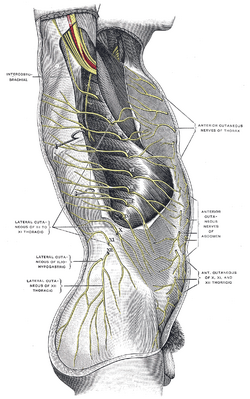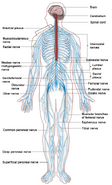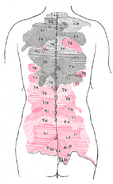No edit summary |
No edit summary |
||
| Line 19: | Line 19: | ||
{{Main|Spinal nerves}} |
{{Main|Spinal nerves}} |
||
| − | The '''thoracic nerves''' are the [[spinal nerves]] emerging from the |
+ | The '''thoracic nerves''' are the [[spinal nerves]] emerging from the thoracic vertebrae. |
==Anterior divisions== |
==Anterior divisions== |
||
Revision as of 08:26, 21 January 2009
Assessment |
Biopsychology |
Comparative |
Cognitive |
Developmental |
Language |
Individual differences |
Personality |
Philosophy |
Social |
Methods |
Statistics |
Clinical |
Educational |
Industrial |
Professional items |
World psychology |
Biological: Behavioural genetics · Evolutionary psychology · Neuroanatomy · Neurochemistry · Neuroendocrinology · Neuroscience · Psychoneuroimmunology · Physiological Psychology · Psychopharmacology (Index, Outline)
| Nerve: Thoracic nerves | ||
|---|---|---|
| Cutaneous distribution of thoracic nerves. | ||
| [[Image:|250px|center|]] | ||
| Latin | nervi thoracici | |
| Gray's | subject #209 923 | |
| Innervates | {{{Innervates}}} | |
| From | {{{BranchFrom}}} | |
| To | {{{BranchTo}}} | |
| MeSH | A08.800.800.720.800 | |
- Main article: Spinal nerves
The thoracic nerves are the spinal nerves emerging from the thoracic vertebrae.
Anterior divisions
- The intercostal nerves come from thoracic nerves T1-T11, and run between the ribs ("costae"). At T2 and T3, it further branches into the intercostobrachial nerve.
- The subcostal nerve comes from nerve T12, and runs below the twelfth rib.
Posterior divisions
The medial branches (ramus medialis; internal branch) of the posterior divisions of the upper six thoracic nerves run between the Semispinalis dorsi and Multifidus, which they supply; they then pierce the Rhomboidei and Trapezius, and reach the skin by the sides of the spinous processes.
The medial branches of the lower six are distributed chiefly to the Multifidus and Longissimus dorsi, occasionally they give off filaments to the skin near the middle line.
Additional images
External links
- Dictionary at eMedicine thoracic+nerves
- Memorial University of Newfoundland - Anatomy at MUN thorax/thornerv
This article was originally based on an entry from a public domain edition of Gray's Anatomy. As such, some of the information contained herein may be outdated. Please edit the article if this is the case, and feel free to remove this notice when it is no longer relevant.
| This page uses Creative Commons Licensed content from Wikipedia (view authors). |




